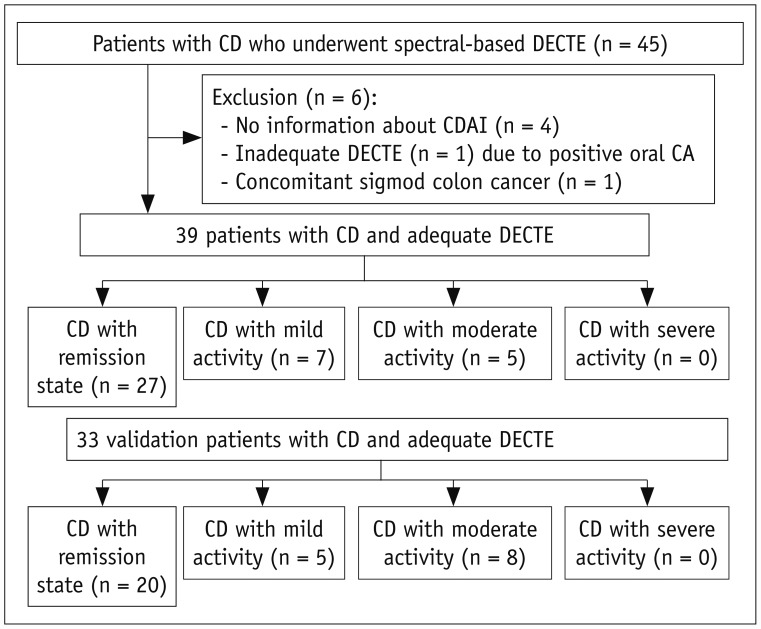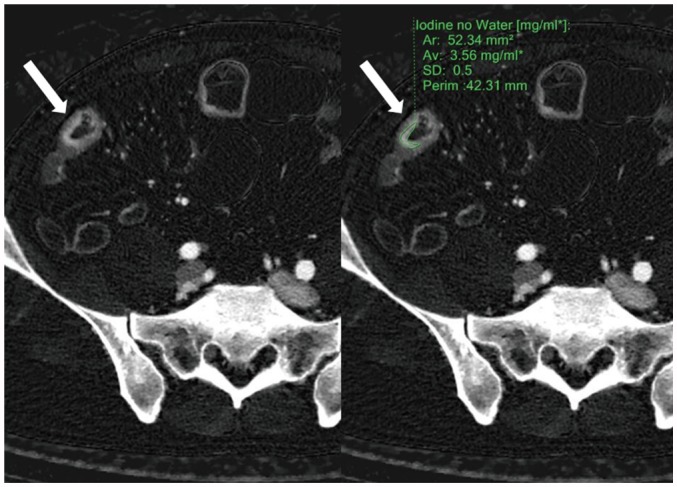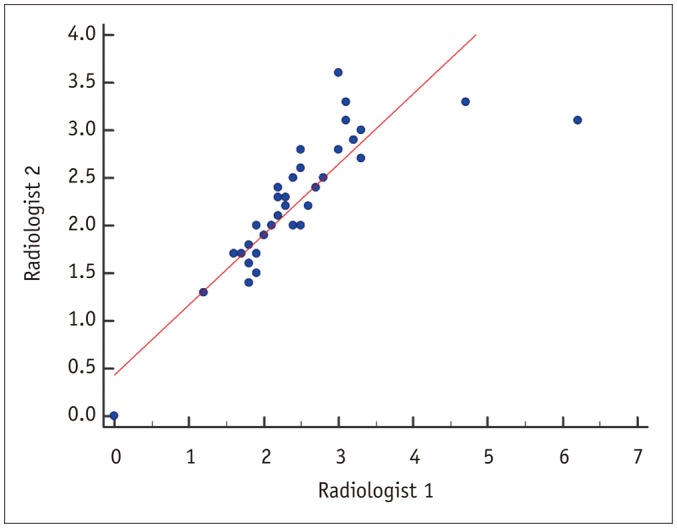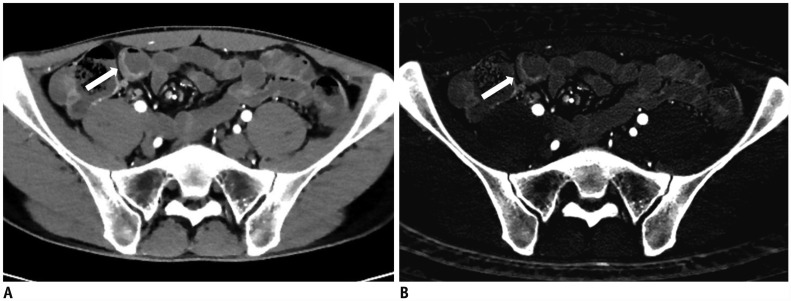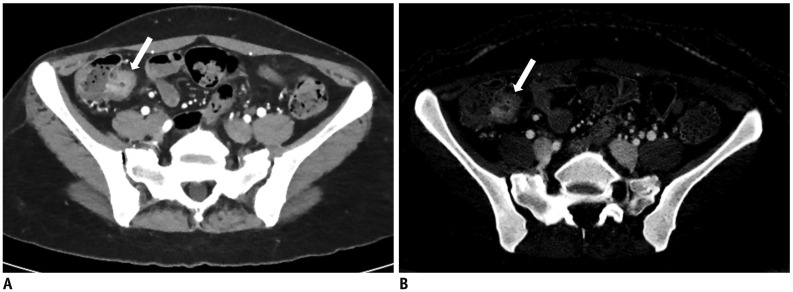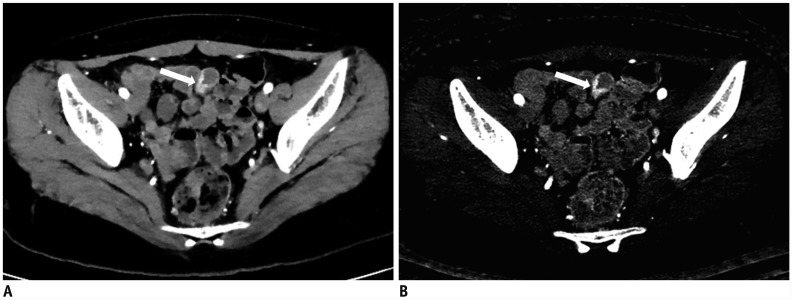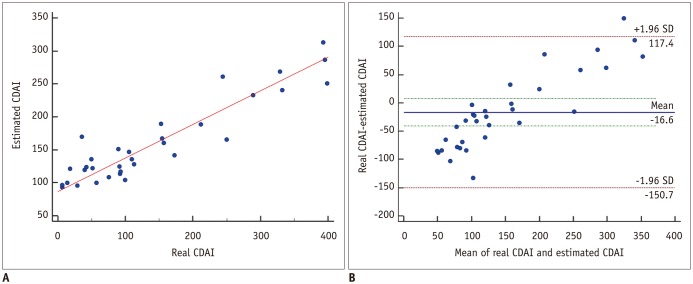Korean J Radiol.
2018 Dec;19(6):1077-1088. 10.3348/kjr.2018.19.6.1077.
Iodine Quantification on Spectral Detector-Based Dual-Energy CT Enterography: Correlation with Crohn's Disease Activity Index and External Validation
- Affiliations
-
- 1Department of Radiology, Seoul National University College of Medicine, Seoul 03080, Korea. shkim7071@gmail.com
- 2Department of Radiology, Seoul National University Hospital, Seoul 03080, Korea.
- 3Institute of Radiation Medicine, Seoul National University Medical Research Center, Seoul 03080, Korea.
- KMID: 2424847
- DOI: http://doi.org/10.3348/kjr.2018.19.6.1077
Abstract
OBJECTIVE
To correlate CT parameters on detector-based dual-energy CT enterography (DECTE) with Crohn's disease activity index (CDAI) and externally validate quantitative CT parameters.
MATERIALS AND METHODS
Thirty-nine patients with CD were retrospectively enrolled. Two radiologists reviewed DECTE images by consensus for qualitative and quantitative CT features. CT attenuation and iodine concentration for the diseased bowel were also measured. Univariate statistical tests were used to evaluate whether there was a significant difference in CTE features between remission and active groups, on the basis of the CDAI score. Pearson's correlation test and multiple linear regression analyses were used to assess the correlation between quantitative CT parameters and CDAI. For external validation, an additional 33 consecutive patients were recruited. The correlation and concordance rate were calculated between real and estimated CDAI.
RESULTS
There were significant differences between remission and active groups in the bowel enhancement pattern, subjective degree of enhancement, mesenteric fat infiltration, comb sign, and obstruction (p < 0.05). Significant correlations were found between CDAI and quantitative CT parameters, including number of lesions (correlation coefficient, r = 0.573), bowel wall thickness (r = 0.477), iodine concentration (r = 0.744), and relative degree of enhancement (r = 0.541; p < 0.05). Iodine concentration remained the sole independent variable associated with CDAI in multivariate analysis (p = 0.001). The linear regression equation for CDAI (y) and iodine concentration (x) was y = 53.549x + 55.111. For validation patients, a significant correlation (r = 0.925; p < 0.001) and high concordance rate (87.9%, 29/33) were observed between real and estimated CDAIs.
CONCLUSION
Iodine concentration, measured on detector-based DECTE, represents a convenient and reproducible biomarker to monitor disease activity in CD.
MeSH Terms
Figure
Cited by 1 articles
-
Crohn’s disease at radiological imaging: focus on techniques and intestinal tract
Giuseppe Cicero, Silvio Mazziotti
Intest Res. 2021;19(4):365-378. doi: 10.5217/ir.2020.00097.
Reference
-
1. Loftus EV Jr. Clinical epidemiology of inflammatory bowel disease: incidence, prevalence, and environmental influences. Gastroenterology. 2004; 126:1504–1517. PMID: 15168363.
Article2. Fishman EK, Wolf EJ, Jones B, Bayless TM, Siegelman SS. CT evaluation of Crohn's disease: effect on patient management. AJR Am J Roentgenol. 1987; 148:537–540. PMID: 3492882.
Article3. Goldberg HI, Gore RM, Margulis AR, Moss AA, Baker EL. Computed tomography in the evaluation of Crohn disease. AJR Am J Roentgenol. 1983; 140:277–282. PMID: 6600342.
Article4. Gore RM, Balthazar EJ, Ghahremani GG, Miller FH. CT features of ulcerative colitis and Crohn's disease. AJR Am J Roentgenol. 1996; 167:3–15. PMID: 8659415.
Article5. Wills JS, Lobis IF, Denstman FJ. Crohn disease: state of the art. Radiology. 1997; 202:597–610. PMID: 9051003.
Article6. Orel SG, Rubesin SE, Jones B, Fishman EK, Bayless TM, Siegelman SS. Computed tomography vs barium studies in the acutely symptomatic patient with Crohn disease. J Comput Assist Tomogr. 1987; 11:1009–1016. PMID: 3680682.
Article7. Rimola J, Rodriguez S, García-Bosch O, Ordás I, Ayala E, Aceituno M, et al. Magnetic resonance for assessment of disease activity and severity in ileocolonic Crohn's disease. Gut. 2009; 58:1113–1120. PMID: 19136510.
Article8. Ordás I, Rimola J, Rodríguez S, Paredes JM, Martínez-Pérez MJ, Blanc E, et al. Accuracy of magnetic resonance enterography in assessing response to therapy and mucosal healing in patients with Crohn's disease. Gastroenterology. 2014; 146:374.e1–382.e1. PMID: 24177375.
Article9. van Hees PA, van Elteren PH, van Lier HJ, van Tongeren JH. An index of inflammatory activity in patients with Crohn's disease. Gut. 1980; 21:279–286. PMID: 7429289.
Article10. Lee SS, Kim AY, Yang SK, Chung JW, Kim SY, Park SH, et al. Crohn disease of the small bowel: comparison of CT enterography, MR enterography, and small-bowel follow-through as diagnostic techniques. Radiology. 2009; 251:751–761. PMID: 19276325.
Article11. Hara AK, Leighton JA, Heigh RI, Sharma VK, Silva AC, De Petris G, et al. Crohn disease of the small bowel: preliminary comparison among CT enterography, capsule endoscopy, small-bowel follow-through, and ileoscopy. Radiology. 2006; 238:128–134. PMID: 16373764.
Article12. Wold PB, Fletcher JG, Johnson CD, Sandborn WJ. Assessment of small bowel Crohn disease: noninvasive peroral CT enterography compared with other imaging methods and endoscopy--feasibility study. Radiology. 2003; 229:275–281. PMID: 12944602.
Article13. Choi IY, Park SH, Park SH, Yu CS, Yoon YS, Lee JL, et al. CT enterography for surveillance of anastomotic recurrence within 12 months of bowel resection in patients with Crohn's disease: an observational study using an 8-year registry. Korean J Radiol. 2017; 18:906–914. PMID: 29089823.
Article14. Choi D, Lee SJ, Cho YA, Lim HK, Kim SH, Lee JW, et al. Bowel wall thickening in patients with Crohn's disease: CT patterns and correlation with inflammatory activity. Clin Radiol. 2003; 58:68–74. PMID: 12565208.
Article15. Bodily KD, Fletcher JG, Solem CA, Johnson CD, Fidler JL, Barlow JM, et al. Crohn disease: mural attenuation and thickness at contrast-enhanced CT Enterography--correlation with endoscopic and histologic findings of inflammation. Radiology. 2006; 238:505–516. PMID: 16436815.
Article16. Makó EK, Mester AR, Tarján Z, Karlinger K, Tóth G. Enteroclysis and spiral CT examination in diagnosis and evaluation of small bowel Crohn's disease. Eur J Radiol. 2000; 35:168–175. PMID: 11000559.17. Booya F, Fletcher JG, Huprich JE, Barlow JM, Johnson CD, Fidler JL, et al. Active Crohn disease: CT findings and interobserver agreement for enteric phase CT enterography. Radiology. 2006; 241:787–795. PMID: 17032911.
Article18. Goo HW, Goo JM. Dual-energy CT: new horizon in medical imaging. Korean J Radiol. 2017; 18:555–569. PMID: 28670151.
Article19. Fulwadhva UP, Wortman JR, Sodickson AD. Use of dual-energy CT and iodine maps in evaluation of bowel disease. Radiographics. 2016; 36:393–406. PMID: 26963452.
Article20. Marin D, Boll DT, Mileto A, Nelson RC. State of the art: dual-energy CT of the abdomen. Radiology. 2014; 271:327–342. PMID: 24761954.
Article21. Thia KT, Sandborn WJ, Lewis JD, Loftus EV Jr, Feagan BG, Steinhart AH, et al. Defining the optimal response criteria for the Crohn's disease activity index for induction studies in patients with mildly to moderately active Crohn's disease. Am J Gastroenterol. 2008; 103:3123–3131. PMID: 18786111.
Article22. Huda W, Ogden KM, Khorasani MR. Converting dose-length product to effective dose at CT. Radiology. 2008; 248:995–1003. PMID: 18710988.
Article23. Frager D, Medwid SW, Baer JW, Mollinelli B, Friedman M. CT of small-bowel obstruction: value in establishing the diagnosis and determining the degree and cause. AJR Am J Roentgenol. 1994; 162:37–41. PMID: 8273686.
Article24. Steward MJ, Punwani S, Proctor I, Adjei-Gyamfi Y, Chatterjee F, Bloom S, et al. Non-perforating small bowel Crohn's disease assessed by MRI enterography: derivation and histopathological validation of an MR-based activity index. Eur J Radiol. 2012; 81:2080–2088. PMID: 21924572.
Article25. Silva AC, Morse BG, Hara AK, Paden RG, Hongo N, Pavlicek W. Dual-energy (spectral) CT: applications in abdominal imaging. Radiographics. 2011; 31:1031–1046. PMID: 21768237.
Article26. Patino M, Prochowski A, Agrawal MD, Simeone FJ, Gupta R, Hahn PF, et al. Material separation using dual-energy CT: current and emerging applications. Radiographics. 2016; 36:1087–1105. PMID: 27399237.
Article27. Coursey CA, Nelson RC, Boll DT, Paulson EK, Ho LM, Neville AM, et al. Dual-energy multidetector CT: how does it work, what can it tell us, and when can we use it in abdominopelvic imaging? Radiographics. 2010; 30:1037–1055. PMID: 20631367.
Article28. Potretzke TA, Brace CL, Lubner MG, Sampson LA, Willey BJ, Lee FT Jr. Early small-bowel ischemia: dual-energy CT improves conspicuity compared with conventional CT in a swine model. Radiology. 2015; 275:119–126. PMID: 25426772.
Article29. Modigliani R, Mary JY, Simon JF, Cortot A, Soule JC, Gendre JP, et al. Clinical, biological, and endoscopic picture of attacks of Crohn's disease. Groupe d'Etude Thérapeutique des Affections Inflammatoires DigestivesEvolution on prednisolone. Gastroenterology. 1990; 98:811–881. PMID: 2179031.30. Eklund C, Lehtimäki T, Hurme M. Epistatic effect of C-reactive protein (CRP) single nucleotide polymorphism (SNP) +1059 and interleukin-1B SNP +3954 on CRP concentration in healthy male blood donors. Int J Immunogenet. 2005; 32:229–232. PMID: 16026589.
Article31. Russell AI, Cunninghame Graham DS, Shepherd C, Roberton CA, Whittaker J, Meeks J, et al. Polymorphism at the C-reactive protein locus influences gene expression and predisposes to systemic lupus erythematosus. Hum Mol Genet. 2004; 13:137–147. PMID: 14645206.
Article32. Uhrig M, Simons D, Kachelrieß M, Pisana F, Kuchenbecker S, Schlemmer HP. Advanced abdominal imaging with dual energy CT is feasible without increasing radiation dose. Cancer Imaging. 2016; 16:15. PMID: 27329159.
Article33. Purysko AS, Primak AN, Baker ME, Obuchowski NA, Remer EM, John B, et al. Comparison of radiation dose and image quality from single-energy and dual-energy CT examinations in the same patients screened for hepatocellular carcinoma. Clin Radiol. 2014; 69:e538–e544. PMID: 25291959.
Article34. Xin L, Yang X, Huang N, Du X, Zhang J, Wang Y, et al. The initial experience of the upper abdominal CT angiography using low-concentration contrast medium on dual energy spectral CT. Abdom Imaging. 2015; 40:2894–2899. PMID: 26036793.
Article35. Gandhi NS, Baker ME, Goenka AH, Bullen JA, Obuchowski NA, Remer EM, et al. Diagnostic accuracy of CT enterography for active inflammatory terminal ileal Crohn disease: comparison of full-dose and half-dose images reconstructed with FBP and half-dose images with SAFIRE. Radiology. 2016; 280:436–445. PMID: 27077382.
Article
- Full Text Links
- Actions
-
Cited
- CITED
-
- Close
- Share
- Similar articles
-
- Dual-Energy CT: New Horizon in Medical Imaging
- Comparative Study between Axial and Coronal Planes of CT Enterography in Evaluation of Disease Activity and Complications of Crohn Disease
- Spectral CT Multiparameter Angiography in the Diagnosis of Aortic Stent Endoleak
- Comprehensive Review of Magnetic Resonance Enterography-Based Activity Scoring Systems for Crohn’s Disease
- Virtual Non-Contrast CT Using Dual-Energy Spectral CT: Feasibility of Coronary Artery Calcium Scoring

